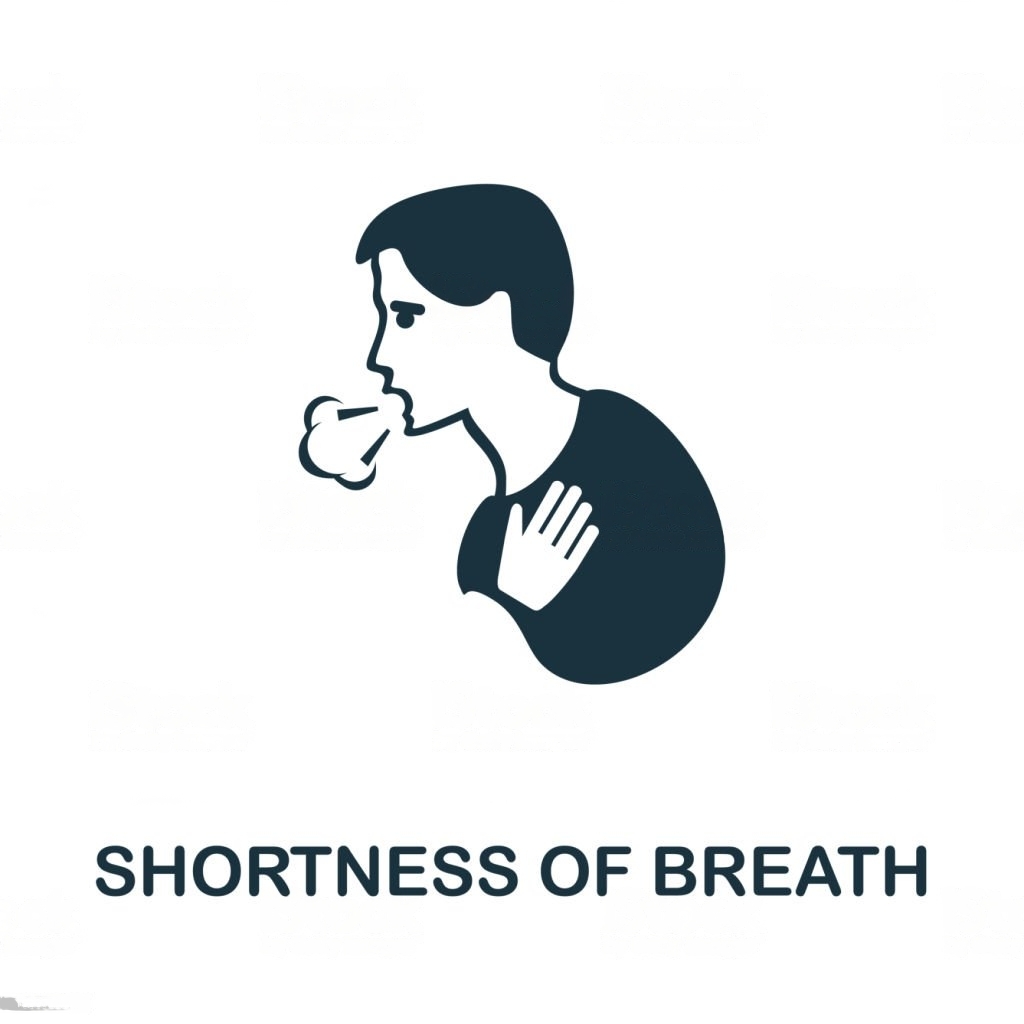How To Tell If Shortness Of Breath Is From Anxiety Or Heart Problems?
Shortness of breath can be a distressing symptom that may arise from various causes, including anxiety or underlying heart conditions. However, differentiating between the two can be challenging, as they share overlapping symptoms.
In this blog, we will delve into the intricacies of shortness of breath, explore the potential connections to anxiety and heart problems, and provide valuable insights to help you discern the root cause. Understanding the distinguishing factors can empower you to seek appropriate care and alleviate concerns effectively.
I. Understanding Shortness of Breath:
Shortness of breath, medically known as dyspnea, is a distressing symptom characterized by the sensation of breathlessness or difficulty breathing. It can manifest as a tightening in the chest, rapid breathing, or a feeling of suffocation. Shortness of breath can be caused by various factors, including physical exertion, respiratory conditions, anxiety, or underlying heart problems.
When it comes to understanding shortness of breath, it's essential to consider its potential causes and accompanying symptoms. Physical exertion, such as intense exercise or strenuous activity, can lead to temporary shortness of breath as the body requires more oxygen. However, if shortness of breath occurs even during minimal exertion or at rest, it could be a sign of an underlying health issue.
Respiratory conditions, such as asthma, chronic obstructive pulmonary disease (COPD), or pneumonia, can also cause shortness of breath. These conditions affect the airways and lung function, leading to breathing difficulties.
Related:- How To Help Someone With An Anxiety Attack?
II. Unraveling the Link between Shortness of Breath and Anxiety:
Shortness of breath can be a distressing symptom that individuals with anxiety often encounter. Anxiety is a common mental health condition characterized by excessive worry, fear, and heightened physiological arousal.
When anxiety sets in, it can trigger a range of physical responses, including shortness of breath. This sensation may leave individuals feeling as though they are not getting enough air, leading to increased respiratory rate and a sense of breathlessness.
One key aspect of understanding the link between anxiety and shortness of breath is recognizing the role of hyperventilation. During times of heightened anxiety, individuals may involuntarily take rapid, shallow breaths, resulting in excessive intake of oxygen and the expulsion of carbon dioxide. This imbalance in oxygen and carbon dioxide levels can lead to various symptoms, including dizziness, lightheadedness, tingling sensations, and, of course, shortness of breath. These physical manifestations can intensify the anxiety itself, creating a cycle of breathlessness and worry.
III. Exploring Shortness of Breath as a Potential Indicator of Heart Problems:
Shortness of breath is a symptom that should never be overlooked, as it can sometimes indicate underlying heart problems. When the heart is unable to pump blood effectively, fluid can accumulate in the lungs, leading to breathlessness. This can be a result of conditions such as heart failure, coronary artery disease, or arrhythmias.
If you experience shortness of breath accompanied by other symptoms like chest pain, fatigue, or rapid heartbeat, it is crucial to seek medical attention promptly. A healthcare professional will perform a thorough evaluation, which may include physical examinations, medical history review, and diagnostic tests, to determine the underlying cause of your symptoms and provide appropriate treatment options. Early detection and intervention for heart-related issues can significantly improve outcomes and prevent further complications.
Recognizing the potential connection between shortness of breath and heart problems is vital, as it can help individuals take proactive steps toward heart health. Understanding the risk factors associated with heart disease, such as high blood pressure, high cholesterol levels, smoking, obesity, and a sedentary lifestyle, can empower individuals to make lifestyle modifications and seek regular cardiovascular check-ups.
Maintaining a heart-healthy lifestyle through regular exercise, a balanced diet, stress management, and appropriate medical care can reduce the risk of heart problems and the incidence of shortness of breath. It is important to prioritize heart health and work closely with healthcare professionals to ensure early detection, prevention, and effective management of any potential heart-related issues.
Related:- What is dyspnea (shortness of breath)?
IV. Identifying Red Flags for Heart Problems
Your heart is an essential organ responsible for pumping blood and oxygen throughout your body. It's crucial to be mindful of any signs or symptoms that may indicate potential heart problems.
Chest Discomfort or Pain:
Understanding the nature of chest discomfort is essential. Any persistent chest pain, pressure, or tightness, especially in the center or left side of the chest, should never be ignored. It may be a sign of angina, a heart attack, or other cardiac conditions.
Shortness of Breath:
Unexplained or sudden onset shortness of breath, even without physical exertion, can be a warning sign of heart problems. If you find yourself struggling to catch your breath or experiencing breathlessness during routine activities, it's important to consult a healthcare professional.
Irregular Heartbeat:
Palpitations or an irregular heartbeat can indicate underlying heart rhythm abnormalities. If you notice a racing or pounding heart, skipped beats, or a sense that your heart is "fluttering," it's advisable to seek medical evaluation.
Fatigue and Weakness:
Persistent fatigue and weakness, even with adequate rest, can be a symptom of heart problems. If you find yourself feeling excessively tired or unable to perform daily tasks without exhaustion, it's essential to consider a heart evaluation.
Read more:- Understanding and Managing Anxiety: A Comprehensive Guide
Swelling in the Lower Extremities:
Unexplained swelling in the ankles, feet, legs, or abdomen may be a sign of fluid retention, often associated with heart failure or other cardiovascular conditions. If you notice sudden or significant swelling, consult a healthcare professional.
Dizziness or Fainting:
Recurrent episodes of dizziness, lightheadedness, or fainting should not be ignored, as they may indicate inadequate blood flow to the brain, potentially caused by an underlying heart condition.
Persistent Cough or Wheezing:
A chronic cough, accompanied by white or pink-tinged phlegm, may indicate fluid accumulation in the lungs, possibly due to heart failure. Similarly, wheezing or shortness of breath worsened by lying flat may be a cause for concern.
V. Seeking Medical Evaluation and Support
Experiencing shortness of breath can be a concerning symptom, especially when trying to determine if it stems from anxiety or underlying heart problems. Deciphering the underlying cause is crucial for proper treatment and peace of mind.
Seeking Medical Evaluation and Support
When experiencing shortness of breath, determining whether it stems from anxiety or an underlying heart condition can be a daunting task. Seeking medical evaluation and support is crucial in obtaining an accurate diagnosis and appropriate care.
Recognizing the Need for Medical Evaluation:
Shortness of breath can have various causes, ranging from benign to potentially serious. If you experience persistent or concerning symptoms, it is essential to recognize the need for medical evaluation. Seeking professional help ensures a comprehensive assessment and appropriate care tailored to your specific situation.
Consulting with a Healthcare Professional:
Initiating a conversation with a healthcare professional is the first step toward understanding the root cause of your shortness of breath. By sharing your symptoms, medical history, and any relevant information, you enable the healthcare provider to develop an informed approach to evaluation and diagnosis.
Related:- How Long Does An Anxiety Attack Last?
Comprehensive Assessment and Physical Examination:
During a medical evaluation, the healthcare professional will perform a comprehensive assessment, which may include a thorough physical examination. They will listen to your heart and lungs, check your vital signs, and evaluate any potential signs or symptoms related to anxiety or heart problems.
Reviewing Medical History and Risk Factors:
Providing your medical history and discussing any relevant risk factors can aid in the evaluation process. The healthcare professional will inquire about your personal and family medical history, previous cardiac conditions, and any known anxiety disorders. This information helps identify potential predisposing factors and guide further diagnostic considerations.
Diagnostic Tests and Collaborative Approaches:
To differentiate between anxiety-induced shortness of breath and heart-related concerns, the healthcare professional may recommend specific diagnostic tests. These may include electrocardiogram (ECG), stress test, echocardiogram, blood tests, or pulmonary function tests. Collaborating with specialists such as cardiologists, pulmonologists, or mental health professionals may also be necessary to ensure a comprehensive evaluation.
Importance of Open Communication:
Throughout the evaluation process, open communication with your healthcare provider is vital. Express any concerns, ask questions, and provide feedback on your symptoms and their impact on your daily life. This information helps the healthcare professional make informed decisions regarding further evaluation, treatment options, and ongoing care.
Following Recommended Treatment and Management:
Based on the evaluation findings, your healthcare professional will provide a diagnosis and recommend an appropriate treatment plan. This may involve addressing anxiety through therapy, medication, or lifestyle modifications, or implementing interventions to manage underlying heart conditions. Adhering to the recommended treatment and management strategies is essential for optimizing your health and well-being.








Post a Comment